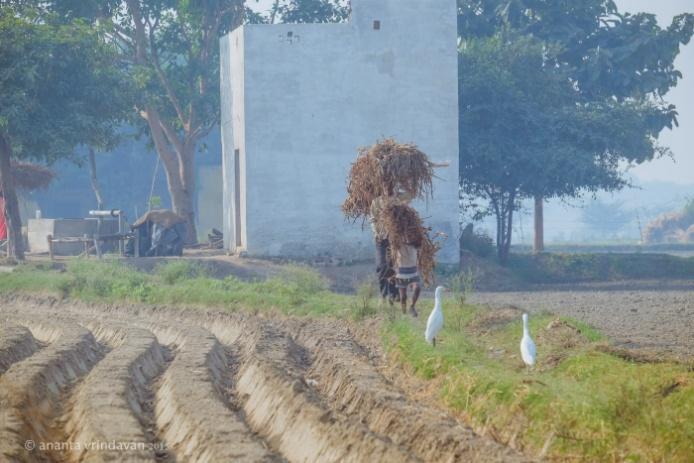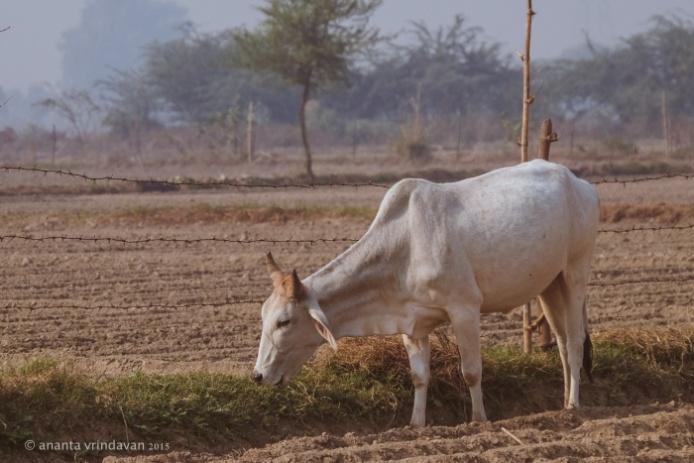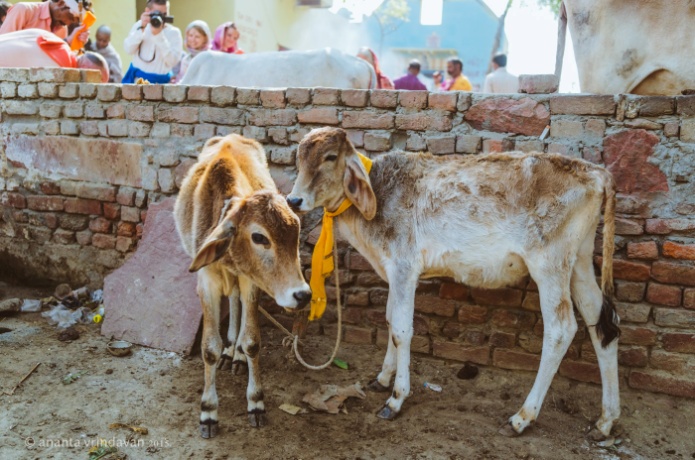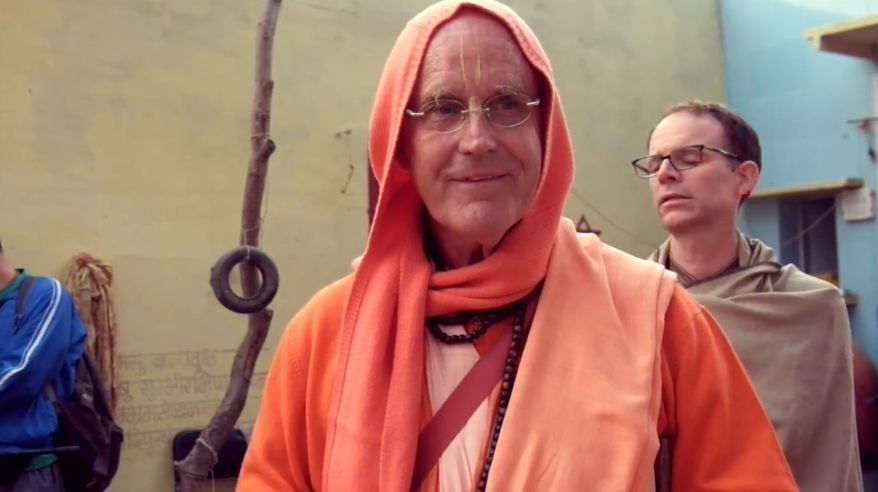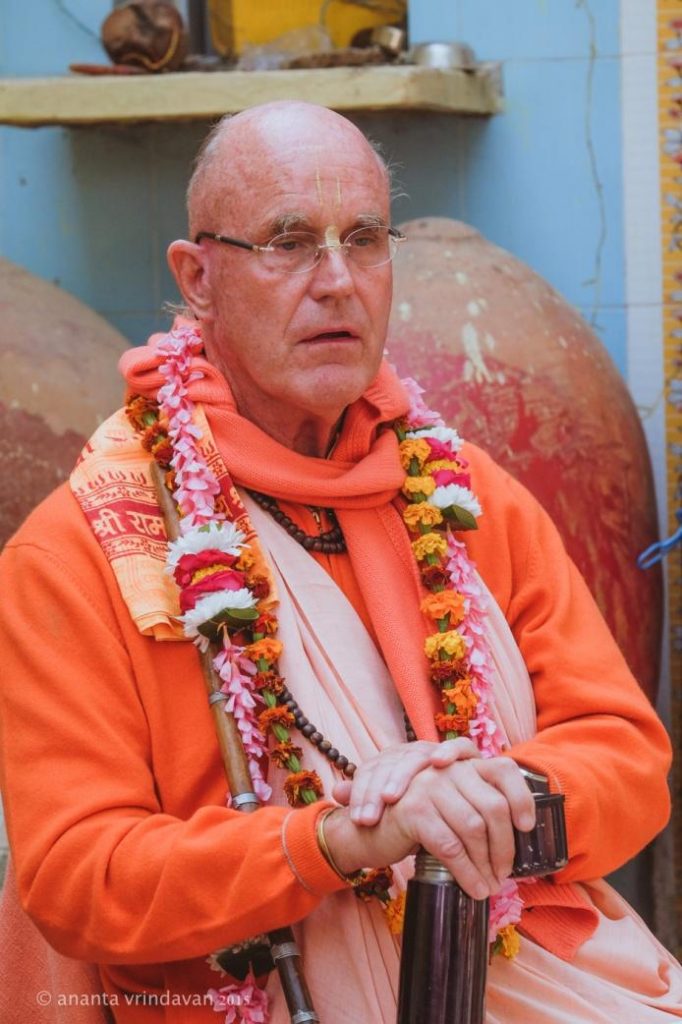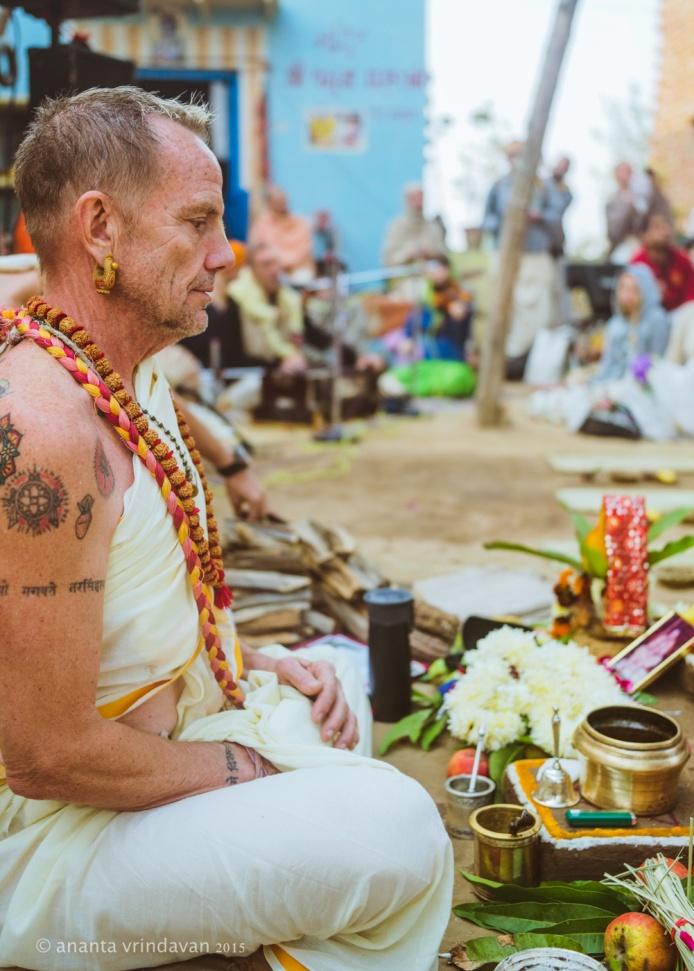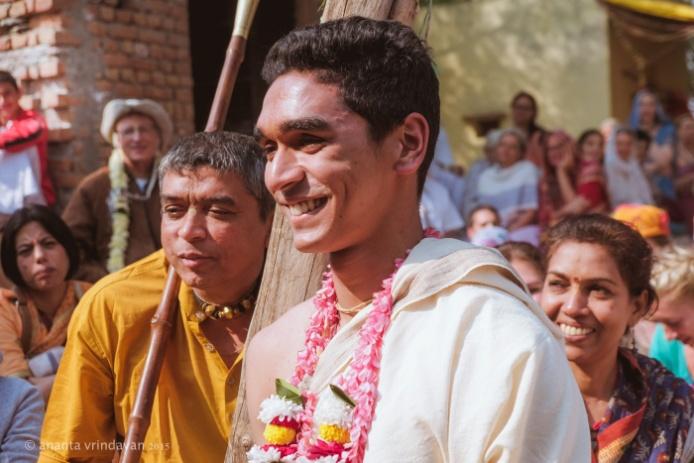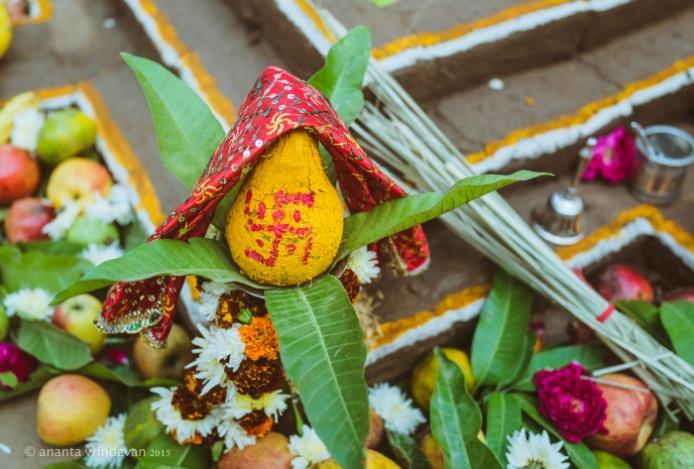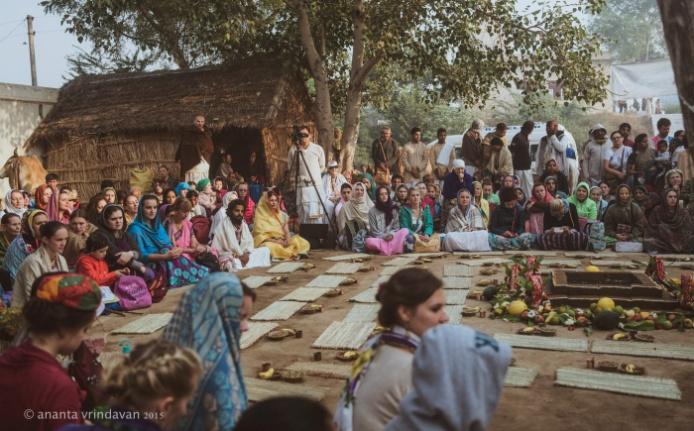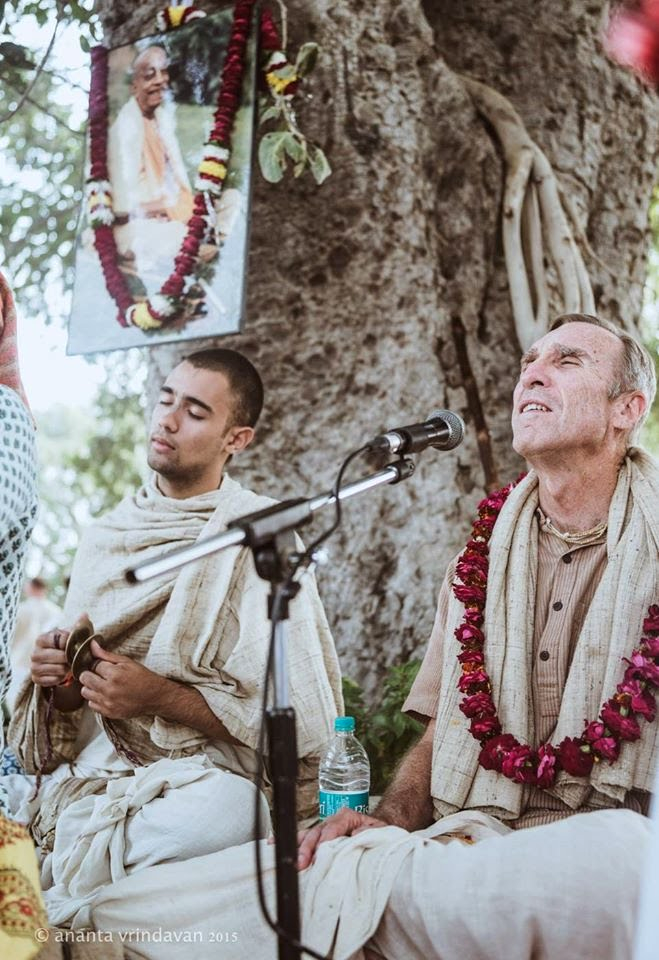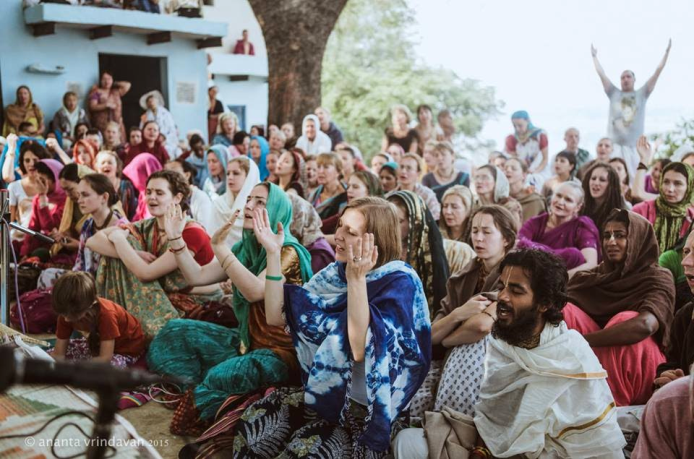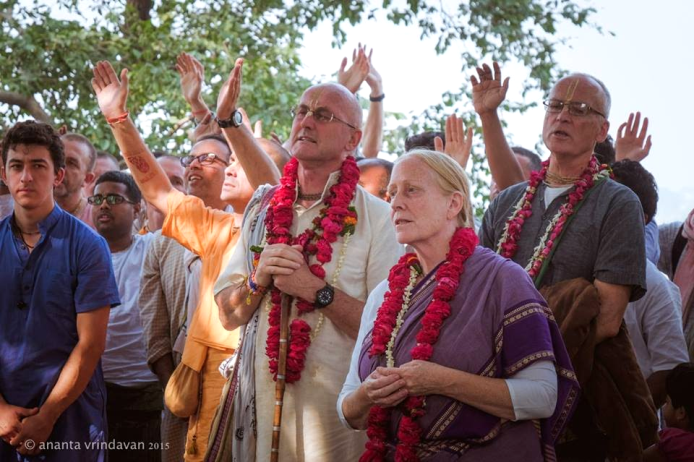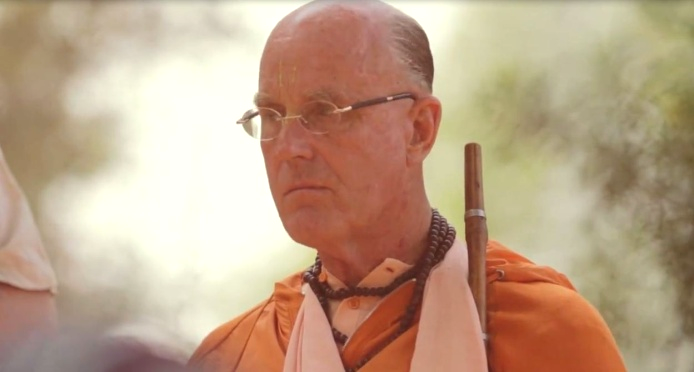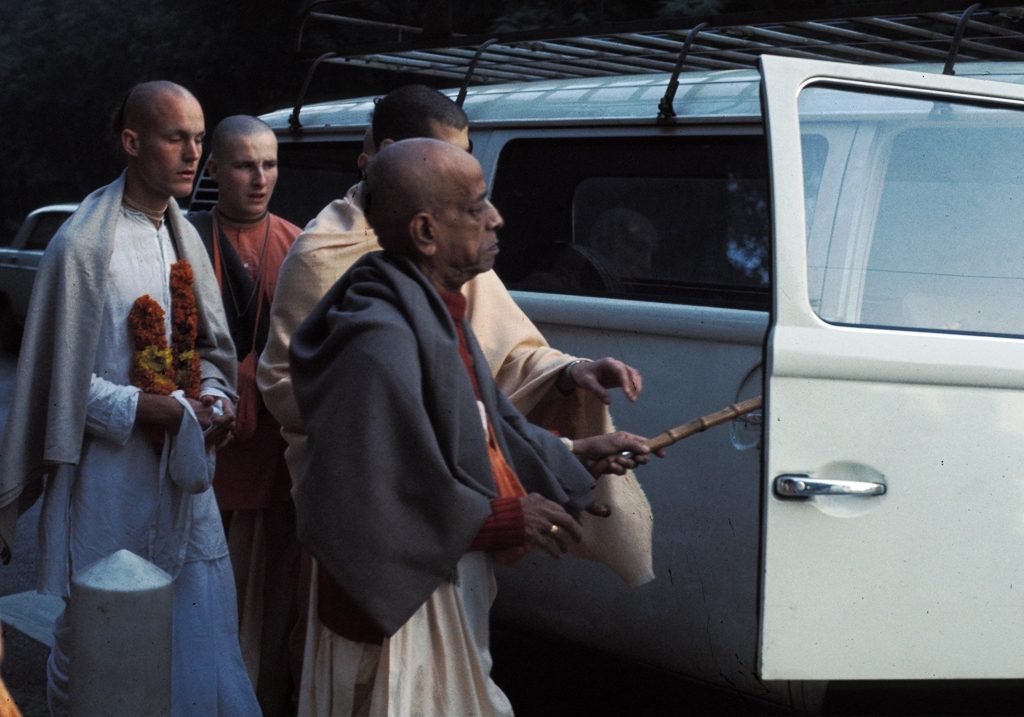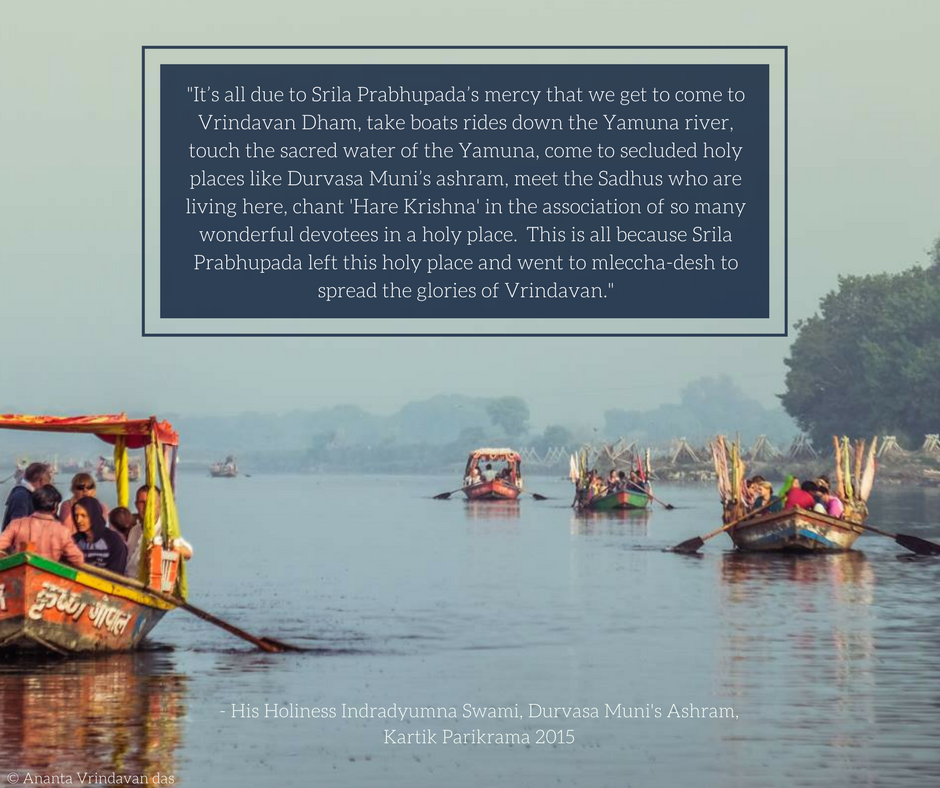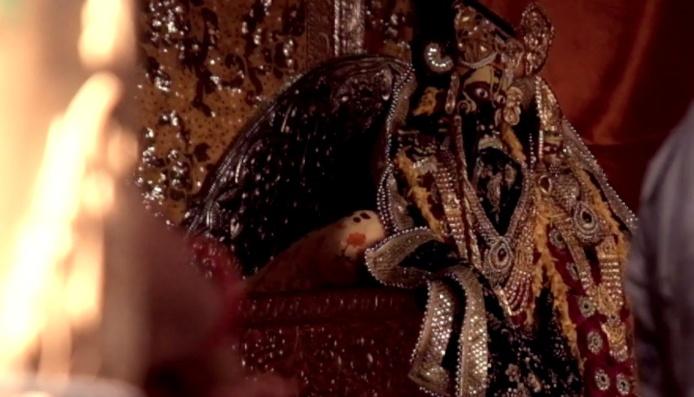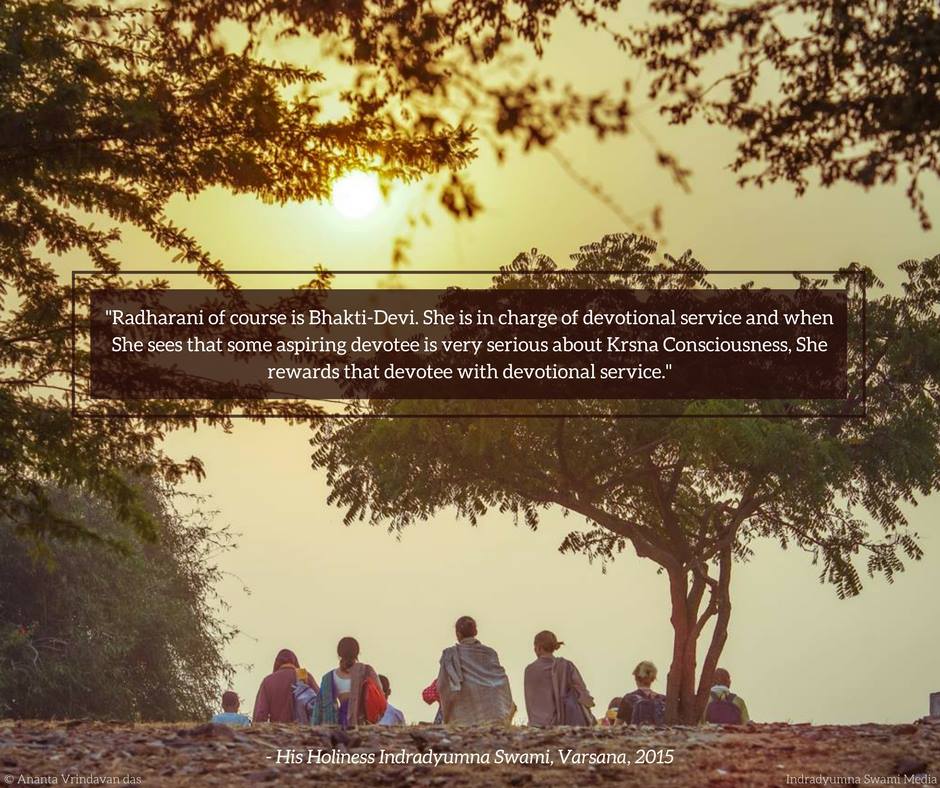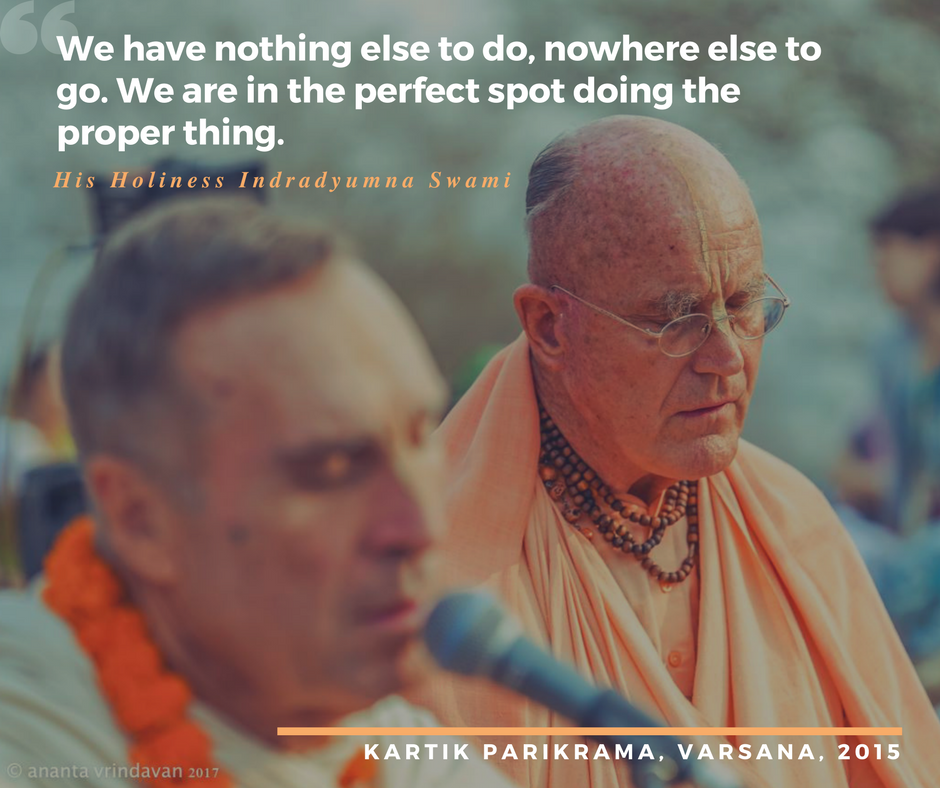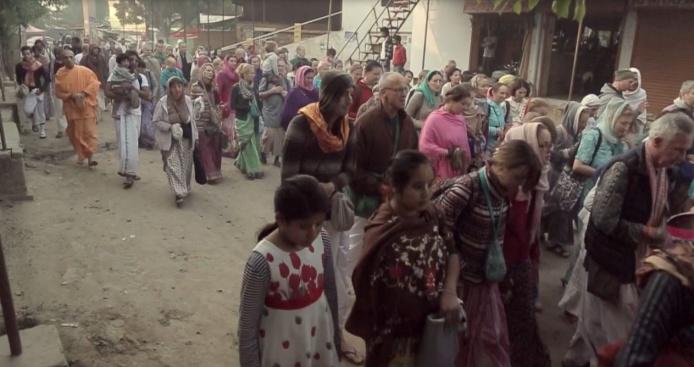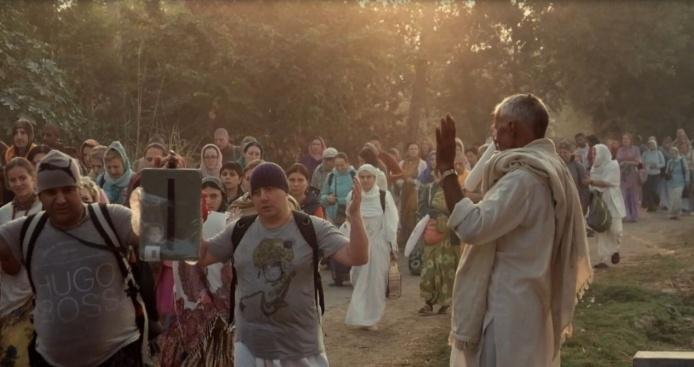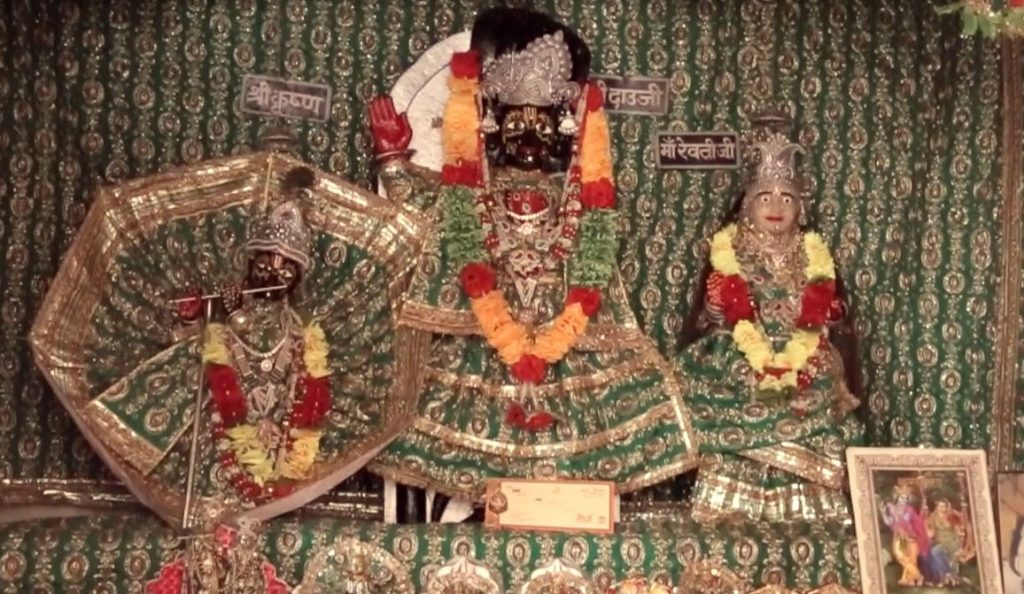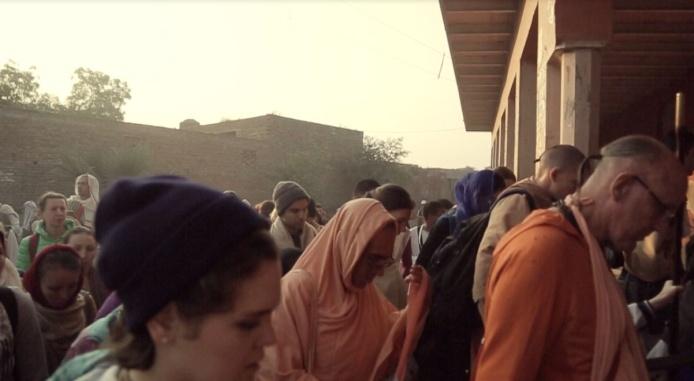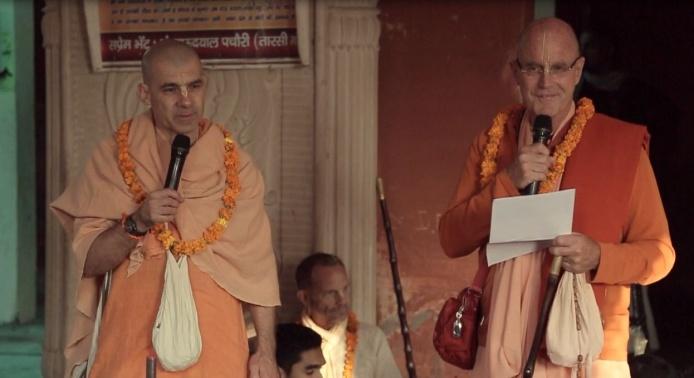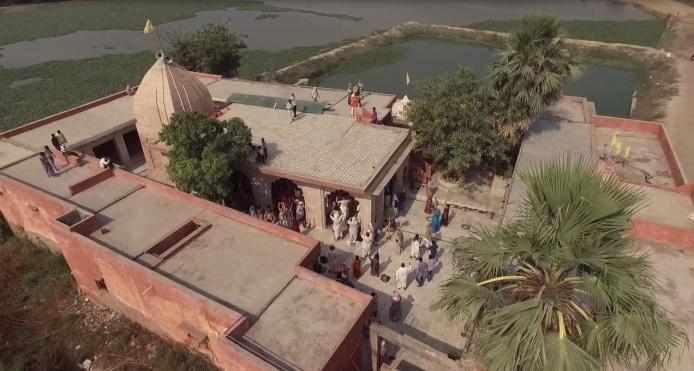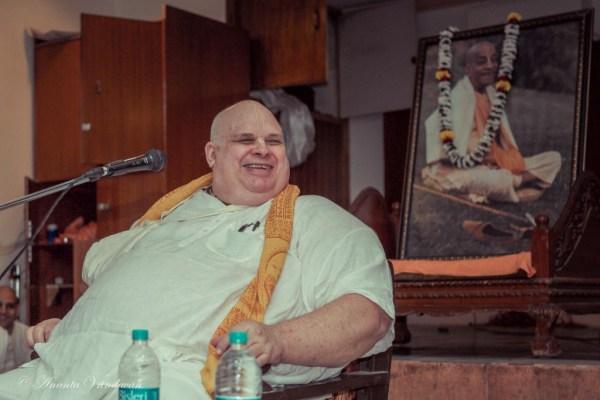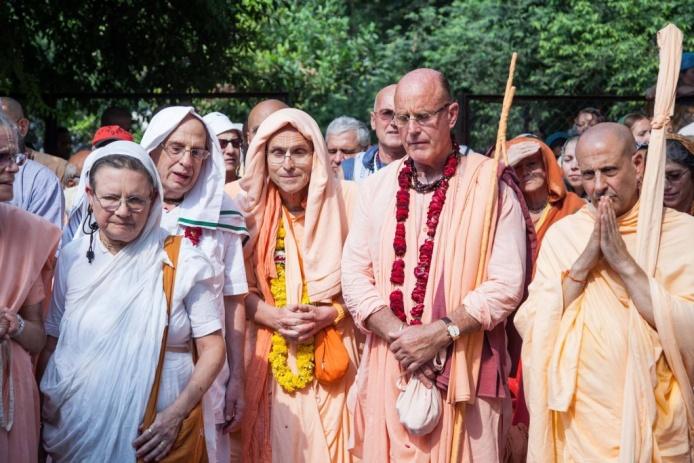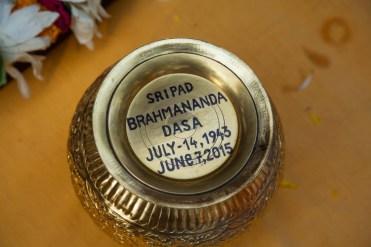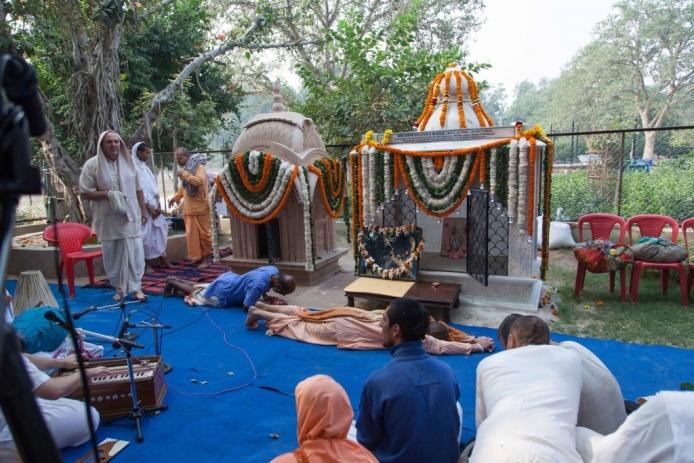– By HG Śrī Prahlāda Prabhu
[Opening prayers…]
We are the most fortunate to be here in Kuru-Kṣetra Dhām, also called as Dharma–Kṣetra. The first verse of the Bhagavad-Gītā, Dhṛtarāṣṭra speaks:
dharma-kṣetre kuru-kṣetre
samavetā yuyutsavaḥ
māmakāḥ pāṇḍavāś caiva
kim akurvata sañjaya
“My dear Sañjaya, at that place of Dharma, place of spirituality, at that place of the Kurus, when my sons and the sons of Pāṇḍu assembled, what did they do?”
Prabhupāda explains in his commentary that Dhṛtarāṣṭra is afraid. He is afraid because he knows that his sons headed by Duryodhana are most sinful. They have violated the codes of Dharma in so many ways. They have stolen the kingdom of the Pāṇḍavas, they have cheated in a gambling match. They have tried to assassinate the Pāṇḍavas in so many ways; by feeding them poisonous food, trying to have them burnt alive in a palace of lak. They are most accustomed to adharma, and this battle will be fought in a place of Dharma. The opposing side, the Pāṇḍava army, is led by Yudhiṣtira Mahārāja—otherwise known as Dharmarāja. Dhṛtarāṣṭra is afraid; this holy place it will give benefit to Dharmarāja Yudhiṣtira Mahārāja and it will act against the victory of Duryodhana and his sons.
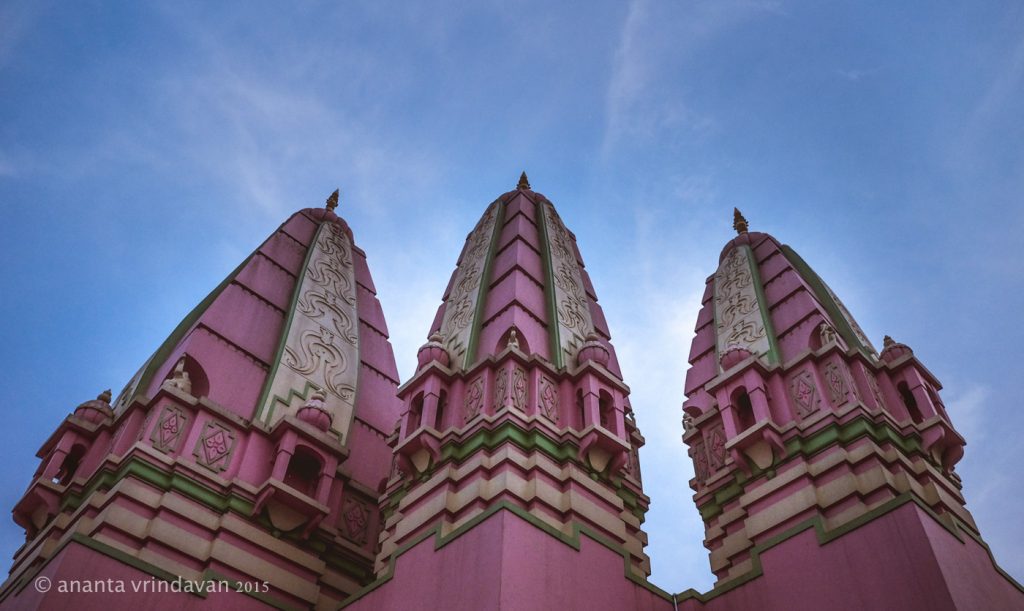
We are here at this Dharma–Kṣetra. We are all trying to practice Bhagavata–Dharma, and the influence of this place will be such that our proclivity, our ability to or inclination to practice Dharma will be further increased. Because we are all aspiring Bhaktas, we are all aspiring devotees, and so the effect of this place will be such that it will nurture our Bhakti, this Dharma–Kṣetra. Kṛṣṇa visited this place twice that we know, as recorded in the Śāstras. Maybe He visited more times as well, but in His pastimes 5,000 years ago we have the record of the Śāstra that He made two visits. One was for the famous Kurukṣetra war that we have been discussing, when He spoke the Bhagavad-Gītā, or we should better say, sung the Bhagavad-Gītā. That is the Song of Bhagavān.
The second time He visited with the Yadus, to bathe in these holy lakes during the solar eclipse. Whatever the chronology of these events, whether one happened before the other, I would like to discuss both in that order, Kṛṣṇa is speaking the Bhagavad-Gītā and Kṛṣṇa is coming here during the solar eclipse and meeting with Vrajavāsīs.
In both of these events, the external purpose is fighting the war or escaping the effects of an inauspicious solar eclipse. These are external reasons. The real purpose of Kṛṣṇa’s coming to this place is to engage in loving reciprocation with His devotees; to also demonstrate to us those loving relationships, as our invitation—“Would you like to join Me in these loving relationships?” That’s Kṛṣṇa’s invitation to all of us. In the Bhagavad-Gītā, this great song of Bhagavān, Kṛṣṇa so mercifully and kindly distills for us the essence of the Veda. There are many ways of analyzing the Bhagavad-Gītā. For today I would like to emphasize one specific point that Kṛṣṇa makes in the Bhagavad-Gītā, wherein He says: ‘vedānta-kṛd veda-vid eva cāham’, that “Indeed, I am the knower, the compiler and the goal of the Veda.”
The Veda is very vast. It consists of thousands and thousands of verses, and they are quite abstract, difficult to understand particularly because they have quite contradictory messages, which lead to debates amongst Vedic scholars, as to the purpose, meaning and teaching of the Veda.
In the Bhagavad-Gītā, Kṛṣṇa so mercifully and beautifully, comprehensively synthesizes all of these apparent contradictory ideas; and demonstrates that they have in fact one essential teaching, one conclusion, one message that we will take from them: love of Kṛṣṇa. That’s it, so let us analyze a little how Kṛṣṇa does this.
We can divide the Vedic literature into six schools; these are the six schools of Vedic knowledge. These can further be divided into—well, summarized into pairs, so we get three divisions. We have the Nyāya and Vaiśeṣika schools of Vedic knowledge. Nyāya means logic given to us by Gautama Ṛṣi. Vaiśeṣika is a method of analysis, bringing things down to their smallest component parts, trying to understand the essence of things by distilling them to their essence, their fundamental components. Then we have Sāṅkhya and Yoga as another pair. The Sāṅkhya system of Vedic understanding describes the world in terms of interactions between Consciousness and matter, or Puruṣa and Prakṛti. The (Aṣṭāṅga) Yoga system is a mechanical system for pacifying the mind, given to us by Patañjali.
Finally, we have the Uttar and Pūrva Mīmāṁsaka Schools. The Pūrva Mīmāṁsaka school is focused on the Veda Saṁhitā, that is the Ṛg, Sāma, Yajur, and Atharva Vedas; they describe sacrifice to the Puruṣa. The Uttara Mīmāṁsaka consists of the Upaniṣadas that is focused on renunciation and meditation on Brahman. Okay, there are the six systems. Let’s now turn to the Bhagavad-Gītā and see how Kṛṣṇa harmonizes these schools into one comprehensive method or application of Vedic knowledge.
We begin with Nyāya and Vaiśeṣika, remember that Nyāya was about logic. Kṛṣṇa doesn’t give us a method of logic in the Bhagavad-Gītā by explaining, these are the different schools, these are the different fallacies, as Gautama does. But the Bhagavad-Gītā is sometimes described as a Nyāya text; because Kṛṣṇa uses a very logical approach to teach His disciple Arjuna. The objective of Nyāya is to overcome faulty thinking or faulty reasoning, and Kṛṣṇa does that. He cuts through Arjuna’s faulty thinking, faulty logic. In that sense Bhagavad-Gītā is described as a Nyāya śāstrā. Let us go to Sāṅkhya and Yoga.
Remember, Sāṅkhya is a system that describes relationship between Puruṣa and Prakṛti. The thirteenth chapter of the Bhagavad-Gītā is where we have Kṛṣṇa presenting a theistic Sāṅkhya philosophy, thirteenth, fourteenth, fifteenth chapters. Arjuna asks questions about the field—that is material nature, and the knower of the field—the living entity—who tries to enjoy the material nature.
Kṛṣṇa’s explanation is very much similar to teachings of Sāṅkhya. Sāṅkhya philosophy describes how material nature, Prakṛti, is activated by Consciousness and becomes dynamic. And from this, it creates what is described as Mahat-Tattva—that then interacts with the modes of material nature, so Consciousness interacting with Tamas, it creates the sense objects—earth, water, fire, air, ether. Then Consciousness interacting with the mode of goodness, it creates the knowledge acquiring senses: our eyes, our ears, our nose, our sense of tongue, touch; that is our ability to engage with the sense objects, as well as the working senses. The mind, as well, is created in this interaction of Consciousness with the Mahat and Rajas. Like this in the thirteenth chapter of the Gītā, Kṛṣṇa describes 24 material elements. But He tells us something more. He says, “ahaḿ bīja–pradaḥ pitā —I am the seed-giving father. It is Me who impregnates the material nature. It is Me who generates or activates this material cosmic manifestation. Everything comes from Me, everything depends on Me, like pearls are strung on a thread.” Sāṅkhya philosophy doesn’t give us that higher understanding, Kṛṣṇa gives it to us.
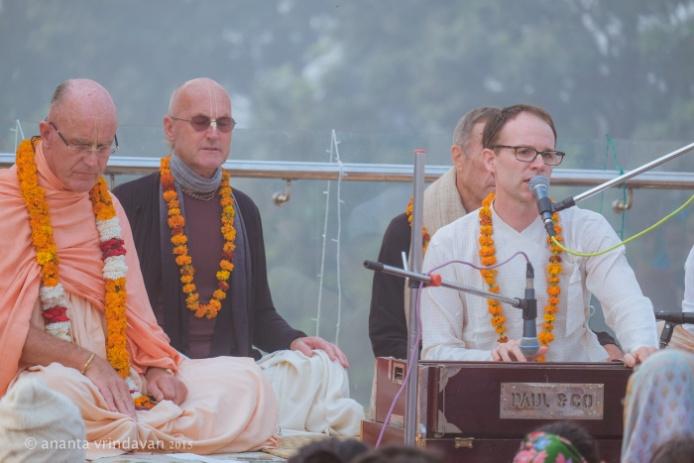
He also tells us about the material modes of nature in chapters 14 and 15. We get a great topography, a great system for understanding all things around us. Kṛṣṇa says, “Food can be categorized according to sattva, rajas, and tamas—goodness, passion, and ignorance. Work can be classified that way. Happiness can be classified that way. Everything can be classified according to these modes of nature. They have different results; Tamas leads to further distress, Rajas leads to a temporary happiness and then distress, Sattva leads to a sustainable happiness.” But Kṛṣṇa doesn’t want us to remain in the modes of nature. He wants us to transcend them. That’s His teaching about the modes in Bhagavad-Gītā that we can transcend the modes of nature by His grace.
daivī hy eṣā guṇamayī, mama māyā duratyayā
This material nature is difficult to overcomes, these gunas are very difficult to overcome but by My mercy, you can do it very easily.
Kṛṣṇa teaches about Yoga in the sixth chapter and eighth chapter of Bhagavad-Gītā. Patañjali’s Yoga system, it’s an eight-fold system. He has given a system to help address the issue of the ‘Citta-Nirodha’—the turnings of the mind, that is the agitated and disturbed mind. He says this can be overcome; Patañjali explains, this can be overcome through an eight-fold process. Yama, Niyama, you practice rules that are prescriptive and restrictive rules, do’s and don’ts. You should be kind, you should be compassionate, you should be forgiving, and you should be charitable. These are rules of right conduct. Niyama, the things you shouldn’t do: don’t steal, don’t lie, don’t kill, and so forth.
Patañjali next describes āsana. Generally in today’s time, people talk about āsana as practicing different Yoga poses; like Vṛkṣāsana, standing like a tree, Virāsana, like a warrior and so on and so forth. When Patañjali describes āsana, it’s about sitting in meditation and that’s how Kṛṣṇa describes āsana in the Bhagavad-Gītā; “Sit in a solitary place, with your spine straight, with your gaze at the tip of your nose.” The next stage Patañjali describes is Prānayama—to regulate the breathing. Kṛṣṇa describes that we should also regulate our breathing in this Yoga practice. Today’s science tells us that the best way to pacify the mind is with extended outward breaths. It tells the body, “You are safe.” When we are afraid, we have very quick breaths and our body knows “Oh, I am in trouble; I am in danger.” When we are feeling safe and satisfied, then our breathing extends. Patañjali teaches this system for pacifying the mind. The next stage is Dhāranā—to hold the mind, fix it. Pratyahāra—withdraw from the external environment—then you can practice Dhyāna—meditation, which will lead to Samādhi, complete absorption. Complete absorption in what? Iśvara Paridhāna, focus on Iśvara, the Supreme.
In the Bhagavad-Gītā, Kṛṣṇa teaches a similar system in the sixth chapter of the Gītā. Arjuna actually rejects it, he says “It’s too hard, Kṛṣṇa. I can’t do that. Fixing the mind in one object is very difficult.” Kṛṣṇa says, “Never mind. It’s just a technique, it’s just a method. The main thing is to think of Me, to love Me, that’s the real purpose of Yoga.”
yoginām api sarveṣāṁ
mad-gatenāntar-ātmanā
śraddhāvān bhajate yo māṁ
sa me yuktatamo mataḥ
[BG 6.47]
Of all the yogis, the best one is the one who always thinks of Me, who has faith in Me, who worships Me, that yogi is Yukta—is connected with Me in love.
That’s the real purpose of Yoga. Patañjali doesn’t teach that. But we learn it in the Bhagavad-Gītā. Let’s move to Uttara and Pūrva Mīmāṁsā, the third pair. Pūrva Mīmāṁsā relates to the Veda; the Veda Saṁhitā—Ṛg, Sāma, Yajur, and Atharva. The Ṛg is the first of these Saṁhitās and the most famous section of the Ṛg Veda is the Puruṣa–suktā. It describes the essence of the Veda, the Veda Saṁhitā’s teachings. It describes the person, the Supreme Person, Puruṣa. How is He described?
sahasra’śīrṣā puru’ṣaḥ
sahasrākṣaḥ sahasra’pāt
sa bhūmi’ṃ viśvato’ vṛtvā
[atya’tiṣṭhaddaśāṅguḷam]
He is described as having thousands and thousands of faces, in all directions. How His faces are? How He has expanded Himself in all directions? How He has expanded as the world, as the universe? This universe is described, as different features, or aspects, of the Puruṣa’s form, even society.
| brāhmaṇo’sya mukha’māsīt |
The brāhmaṇas are His face. |
| bāhū rā’janya’ḥ kṛtaḥ |
His arms, they are the kṣatriyas. |
| ūrū tada’sya yadvaiśya’ḥ |
The merchants, they are His thighs. |
| padbhyāgṃ śūdro a’jāyataḥ |
The sudras are His feet. |
| candramā māna’so jātaḥ |
Now the planets, the demigods, the moon is His mind. |
| cakṣoḥ sūryo’ ajāyata |
His eyes, that is the Sun. |
| Mukhād Indra’ścāgniśca’ |
Indra is His mouth. |
| prāṇādvāyura’jāyata |
And Vayu is His breath |
Like this, the Veda describes the universe as an expansion of Kṛṣṇa, the Puruṣa. So then what are we going to do with that information? We must engage in sacrifice to the Puruṣa. That is the teaching of the Veda. What should we sacrifice? Everything is the Puruṣa. You take the Puruṣa Himself and sacrifice the Puruṣa unto Himself. Why would you do that? Well, actually, human society will derive benefit by doing so. The demigods have rulership over the different aspects of the universe. When human society takes these resources and offers them in sacrifice, it creates a cycle of prosperity. That is the essential teaching of the Veda Saṁhitā.
In the Bhagavad-Gītā, we get to meet this Puruṣa. In Chapter 10, Kṛṣṇa starts telling Arjuna about his vibhuti—about His opulence:
“I am the strength of the strong. Of bodies of water, I am the ocean. Of aquatics, I am the shark. Amongst people, I am the monarch, the ruler” and so on and so forth.
When we meditate on this universe as different aspects of Kṛṣṇa, we can actually become detached. We can appreciate Kṛṣṇa in the universe and become detached from thinking of it as something we can own and possess for ourselves. Rather we feel, “Let me surrender to Kṛṣṇa.” At the end of the tenth chapter, Arjuna says, “You have told me so many wonderful things about Yourself. I would like to see that. Can I see this?” Kṛṣṇa says, “Well, you don’t really have the eyes, the divine eyes necessary to see this divine form of Mine. But I will give you that Divya-Cakṣū—I will give you these divine eyes. Behold My mystic opulence.” What Arjuna saw filled him with wonder. He saw thousands and thousands of faces spread out everywhere. Some of them were benign (means kind), and some of them were very fearful. Arjuna became very afraid. Every face that has existed in this cosmic manifestation is there in the Virat-Rūpa. If you were to look at a painting, you can see the many, many faces. If you could look with a magnifying glass, you could even see your own face there. That’s right. We are all part of this Virat-Rūpa, this universal form of the Lord.
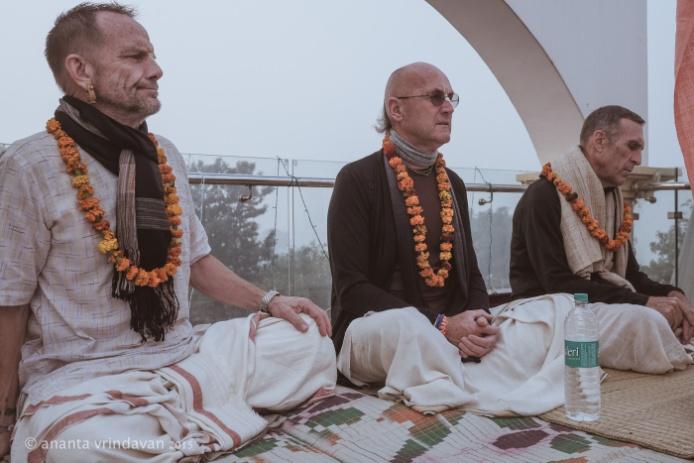
Arjuna saw time—past, present, and future and he became overwhelmed. He realized that Kṛṣṇa is the Puruṣa, described in the Veda. He kind of knew it before, but now that he was seeing this, he was overwhelmed with Kṛṣṇa’s majesty. He offered prayers and he offered apologies, “Kṛṣṇa, please forgive me. I called You ‘friend’. How dare me! I sat on the same bed as You, I joked with You, I called You Yādava, thinking of You as part of a lesser family as my own. Forgive me my arrogance, and accept my humble obeisances from the front, from behind, from the side, I offer You my humble obeisances.” Eventually he asked Kṛṣṇa, “Can You, please, withdraw this form? I can’t behold it any longer. I want to see Your two-handed form, Your form of sweetness.”
The Puruṣa described in the Veda is revealed in the Bhagavad-Gītā to be none other than Kṛṣṇa. What about this idea of offering sacrifices? Kṛṣṇa talks about how we can actually offer sacrifice by doing whatever we do as an offering to Him. Not necessarily that we have Yajña–śālā with ghee and wood and fire and so forth. But that we make this sacrifice consciously in our endeavor to offer all that we do to Kṛṣṇa. The Vedas also describe this ongoing battle between the Devas and the Asuras—the gods, the demigods and the demons. Demigods are responsible for the resources of the universe, they follow Dharma and protect Dharma; and the Asuras, they want to appropriate all of this for themselves, who don’t care for Dharma, but only for power.
In the sixteenth chapter of the Gītā, Kṛṣṇa describes the same conflict; but as something that takes place within us, the divine and the demoniac natures. Not that there are not Asuras and demons, but that as conditioned souls we have these two inclinations. Which one will win? Depends on which one we nurture. We can cultivate or nurture our demoniac nature, wanting to dominate and control and possess, to be superior to all others. Or we can cultivate or nurture our divine nature—and that’s what Kṛṣṇa encourages us to do in the Bhagavad-Gītā.
Okay, we finally come to the Uttara Mīmāṁsā. Now we are at our sixth. I explained that this is generally the teachings of the Upaniṣadas, about a focus on Brahman, renouncing the material nature, understanding the fallacy of identifying with a material body, taking to a spiritual practice, meditation. Right there in the second chapter of the Bhagavad-Gītā, Kṛṣṇa gives these very same teachings. Second chapter of the Bhagavad-Gītā, He explains to Arjuna that, “You are not the body; you are a soul transmigrating from one body to the next.” The second chapter of the Gītā in fact contains many, many verses that are verbatim from the Kathā Upaniṣada.
In chapter four, as well, Kṛṣṇa explains the significance and importance of this transcendental knowledge. As a whole, what do we have in the Bhagavad-Gītā? This incredible synthesis of the entire Vedic knowledge, but it gives us something more. Don’t forget chapters 9, 12, and 18, where the focus is Bhakti. Kṛṣṇa tells us about His loving relationships with His devotees. How He is equal to everybody, but He has special affection for His devotees.
samo ‘haṁ sarva-bhūteṣu
na me dveṣyo ‘sti na priyaḥ
[BG 9.29]
“I am equal to everyone but those devotees that surrender unto Me, they are Mine, I am always within them; they are always within Me. They will never perish, those devotees of Mine, even if they make a mistake, they are still Sādhus, because I declare it so.”
He tells us of how His devotees, they are always thinking of Him. They worship Him. They surrender everything to Him and He delivers them. He brings His devotees out of this material world to join Him in the spiritual world, where life is eternal. He brings them to a place from where they will never return to this material world again. He gives us the Veda and more in the Bhagavad-Gītā and in such a concise and consistent manner, just 700 verses in eighteen chapters. This knowledge should inspire us, that we have nothing to do but surrender to Kṛṣṇa, to love Kṛṣṇa. This knowledge of Kṛṣṇa’s divinity, as the source of all that is, including us, should lead us to surrender to Him.
Yet, in the Śrīmad Bhāgavatam, we are given something even deeper still. That is, we are introduced to different types of devotees: devotees who worship Kṛṣṇa and reciprocate with Kṛṣṇa in different ways. He reciprocates with devotees as Kūrma-avatar, helping them to churn the ocean of milk; as Varāha, who helps them by rescuing the earth that has fallen into the depths of the Garbhodaka Ocean; as Matsya, who helps Satyavrata to rescue and preserve the herbs and other species through the great floods of partial inundation. These relationships, they deepen in the later cantos of the Bhāgavatam.
Narasiṁha, He has much parental affection for His devotee, Prahlāda. Śrī Rāma, in the ninth canto, shows even more loving relations with His devotees, as the ideal son, ideal friend, ideal husband, disciple, king, and in the ninth and in the tenth canto of the Śrīmad Bhāgavatam, we are introduced to Kṛṣṇa. He lives in Vṛndāvana, where He interacts with devotees who don’t even know He is God, who love Him more than anything, even so. Their impetus for loving Kṛṣṇa is not knowledge of His divinity; their impetus for loving Kṛṣṇa is Kṛṣṇa’s own sweetness. Even when they see indications of His divinity, they still don’t get it. Sometimes when Kṛṣṇa returns from the forest to enter into the village of Gokula, and the demigods, they are gathered above in the heavens to witness this beautiful procession of Kṛṣṇa’s return from the forest with His friends. The cows, they are mooing, the boys are playing bugles and flutes, and in the center of it all is Kṛṣṇa. The boys see the demigods, and they think, “Kṛṣṇa is so incredible; He is so amazing, that look—even the demigods have come to see Him. Why wouldn’t they? He is the most handsome, He is the most expert dresser, He is the best flute player; and so despite seeing the demigods, they don’t connect the dots to understand that He is God.
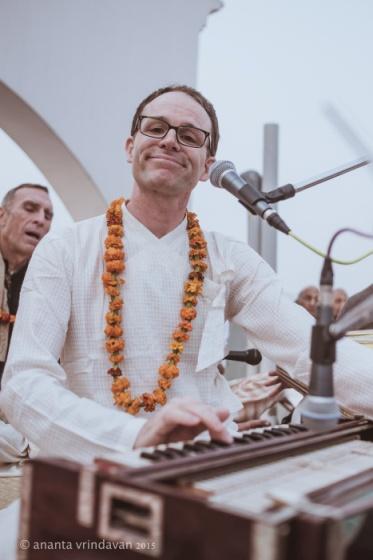
When Kṛṣṇa runs away from the Gopīs, and decides to play a prank as they search for Him in the forest, by standing before them as Lord Nārāyaṇa, they come to Him and they say, “Namo Nārāyaṇa! Have you seen Kṛṣṇa; the son of Mahārāja Nanda, with a peacock feather in His hair, a yellow silken garment that He ties around His waist so expertly? He left us and came somewhere in the forest and we are looking for Him everywhere.” Hello, you are speaking to the Supreme Godhead! Their only interest is Kṛṣṇa.
When Rādhā comes before that same Nārāyaṇa, Kṛṣṇa is unable to maintain His pretense. Her love for Him is so great that He is unable to maintain those four arms. He changes back into His two-armed form of sweetness, because as His devotee looks upon Him, He reciprocates accordingly. When Kṛṣṇa left Vṛndāvana and goes to Mathurā, and finally to Dvārakā; the residents of Vṛndāvana were swept up in these pools of separation; and when they heard He was coming nearby to Kurukṣetra during the solar eclipse, they felt that they were having a second lease on their lives. They finally got to meet Kṛṣṇa. But He didn’t look like that sweet boy that they remembered from Vṛndāvana. In the place of His flute, well instead of His flute, He was holding weapons. Instead of His cowherd’s turban with the peacock’s feather, He had a royal crown on His head. Instead of a procession of cowherd boys with their ropes and their bugles and their sticks for herding cows, He was surrounded by many soldiers, protecting armor. Their hearts were pining to be with that Kṛṣṇa from Vṛndāvana.
The Gopīs finally got to meet with Kṛṣṇa, and He gave them some advice to console them. He said, “In fact, I am the Supreme Godhead. Hence, I am present everywhere as the Puruṣa. I am the Supersoul within the hearts of all living beings, and the yogis meditate on Me, and they feel that they are always with Me. They become Ātmārām —self-satisfied in meditating on Paramātmā.”
When the Gopīs heard these words, they were becoming angrier and angrier. [Gopīs]: “What nonsense He is speaking! Is He the Supreme Personality of Godhead, the Supreme Truth? What lies He speaks! He said He would come back to Vṛndāvana, and we have been waiting for so many years! How He stole butter in His childhood? What about the time that He stole our clothes?—The Supreme Absolute truth, telling us to meditate on His feet like yogis?”
They spoke to Him, they gave their reply, “Our dear Supreme Godhead, the great Yogis, they are able to meditate on Your transcendental feet. The Jñānīs, they have this understanding of Your supreme position. We are unfortunate village girls; we do not know such things.” When you read the text, it looks like some glorification. Our Ācāryas they tell us of the tone in which these verses, these words are spoken. They are words of sarcasm. They are making jest of this Jñāna that Kṛṣṇa is trying to teach them. [Gopīs]: “You want us to remember Your feet like Yogis; and remain satisfied? We can’t forget Your feet! We are trying to forget You! We cannot forget You! We cannot get You out of our minds. If You can teach us the technique for forgetting You, we would be more interested. All we can do is take You in our hearts and beg You; beg You, please, always stay there with us.” The Gopīs’ hearts are non-different from Vṛndāvana. They want Kṛṣṇa to come with them to Vṛndāvana.
Caitanya Mahāprabhu, He took great relish in remembering this pastime during the Ratha-Yātrā festival. He was dancing in front of Jagannātha’s chariot and He was thinking that He is taking Kṛṣṇa from Kurukṣetra to Vṛndāvana. Sometimes He would go behind Jagannātha’s chariot just to see what Jagannātha will do. Jagannātha’s chariot would become immobile. They would pull with all of their strength and the chariot would not move. The king would bring his elephants and soldiers to pull that chariot, and then Śrī Caitanya would go and start dancing in front of that chariot and then Jagannātha’s chariot would start moving again. As He sung and He danced, tears flooded from His eyes like rain. His hair on His body was standing erect and He was singing a poem. This poem caused great confusion to the people who were observing Caitanya’s dancing. It was a secular love poem, nothing from any Śāstra. It was a love poem that said, “You are the same boy; I am the same girl. These are the same moonlit nights in the month of Caitra. But My heart is not happy. Oh, how I long to return to the bank of the Revā, under the Tulasi tree.” This is the song Caitanya was singing.
People were very confused; the Sannyāsī is singing a love poem that has nothing to do with transcendence. Yeah, you might hear some song on the radio, and you like the line, you like the words and if you were singing it in the Ratha-Yātrā, people would think it’s odd. Right? It would be strange. That’s what Caitanya was doing and people were a bit confused. The next day Caitanya went to visit Haridāsa Ṭhākur. Haridāsa Ṭhākur’s Bhajan kutir had a thatched roof and as Caitanya was entering, He saw a piece of manuscript—that is a palm leaf pushed into the thatch. He pulled it out and He read it. It said, “Oh my friend, He is the same Kṛṣṇa. I am the same Rādhā. These are the same moonlit nights. Now we are here in Kurukṣetra. Oh, how I long to return to the bank of the Yamunā River. Oh how I long to be with Him there under the Kadamba trees.” When Caitanya read this, He experienced ecstasy and He asked, “Who has understood my Mind? Who has written this?” The devotees said it was Rūpa Gosvāmī. Caitanya was so pleased with Rūpa. He had Him come to sit amongst His associates, He showed them the verse, and He asked, “How is it possible that he has understood My mind?” They said, “Surely, it must be that you have empowered him to reveal the treasures of Your heart.” These very high spiritual truths of loving Kṛṣṇa, they are difficult to express in philosophical terms and so Caitanya borrowed the language of poetry; and following in His footsteps, Rūpa borrows the language of poetry to express these very intense spiritual feelings. His Bhakti-Rasāmṛta-Sindhu—borrows the aesthetics of the language of poetics to explain the science of Bhakti.
Here we are in Kurukṣetra, we are remembering Kṛṣṇa speaking the Bhagavad-Gītā, and we should pray. We need that understanding of Kṛṣṇa’s divinity. Let us pray that those teachings become manifest in our heart, that we can become attached to Kṛṣṇa and detached from the material nature. But let’s also pray simultaneously that our Bhakti not be stifled or inhibited, that our love not be inhibited at higher levels by our knowledge of Kṛṣṇa’s divinity. But that we might join the residents of Vṛndāvana who have forgotten of Kṛṣṇa’s divinity and in whose company Kṛṣṇa Himself has forgotten His own divinity and is swept up in love. We need both. We need to know of Kṛṣṇa’s divinity; we also want to be able to forget it in the right way. As followers of Śrī Caitanya Mahāprabhu we will be given both. If we pray, if we follow Śrī Caitanya Mahāprabhu and the process that He has given us—that is the invitation we have. Both invitations have been made: Kṛṣṇa has extended both invitation with His both pastimes here in Kurukṣetra; both opportunities are there for us. It’s up for us to be eager to take those opportunities. Okay, we will conclude there. Thank you very much.
Śrī Kurukṣetra dHama ki—Jaya!
Śrī Vrajendra Nandana Kṛṣṇa ki—Jaya!
Bhagavad-Gītā As It is ki—Jaya!
Śrīmad Bhāgavatam ki—Jaya!
Vṛndāvanesvari Śrīmatī Rādhārāṇī ki—Jaya!
Śrīla Prabhupāda ki—Jaya!
Nitai Gaura Premanande!—Haribol
